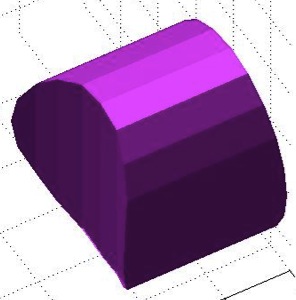FLofVLELn
by Tim C. Lueth, SG-Lib Toolbox: SolidGeometry 5.6 - FL/Facet Lists
Introduced first in SolidGeometry 2.1, Creation date: 2014-12-30, Last change: 2025-09-14
returns the facet list for a vertex list and a planar edge list in 3D
Description
Similiar to FLofVLEL, using delaunayTri, bit in addition the contour is decomposed in facet with same normal vectors. The result is much better than FLofVLEL/Delaunaytri, if enough vertices are used.
Use FLofVLELn (VL,EL,n) in combination with feature edges
Use FLofVLEL2 (VL,EL) for optimal results
Use FLofVLEL (VL,EL) for delaunay results
Use FLofVL for quick and dirty results
It is used in combination with feature edges.
Example Illustration

Syntax
FL=FLofVLELn(VL,EL,nv)
Input Parameter
VL: | | Vertex list |
EL: | | Edge list |
nv: | | normal vector, has to be correct |
Output Parameter
Copyright 2014-2025 Tim C. Lueth. All rights reserved. The code is the property of Tim C. Lueth and may not be redistributed or modified without explicit written permission. This software may be used free of charge for academic research and teaching purposes only. Commercial use, redistribution, modification, or reverse engineering is strictly prohibited. Access to source code is restricted and granted only under specific agreements. For licensing inquiries or commercial use, please contact: Tim C. Lueth
Algorithm (Workflow)
This function, FLofVLELn, is designed to generate a facet list from a given vertex list and a planar edge list in 3D space. It uses Delaunay triangulation and decomposes the contour into facets with the same normal vectors for improved results.
Input Parameters
- VL: Vertex list, a matrix where each row represents a vertex in 3D space.
- EL: Edge list, a matrix where each row represents an edge by specifying two vertex indices.
- nv: Normal vector, a 3D vector that must be correctly specified to ensure accurate facet orientation.
Output
- FL: Facet list, a matrix where each row represents a facet by specifying vertex indices.
Algorithm Steps
- Extract the first vertex from the edge list and calculate the vector
ex as the difference between the second and first vertex of the first edge.
- Set
ez as the normal vector nv.
- Calculate
ey as the cross product of ez and ex to ensure orthogonality.
- Construct a transformation matrix
T using the normalized vectors ex, ey, and ez, and the translation vector t.
- Call
VLELselect to filter the vertex and edge lists, obtaining VLN, SI, and ELN.
- Transform the vertex list
VLN using the inverse of the transformation matrix T.
- Create a Delaunay triangulation
TR2 using the transformed vertex list and edge list.
- Extract the interior facets from the triangulation using
isInterior and store them in NFL.
- Map the indices from
NFL back to the original vertex list using SI to form the final facet list FL.
- If the output is not requested, plot the vertices and facets using
VLFLplot.
Algorithm explaination created using ChatGPT on 2025-08-19 01:16. (Please note: No guarantee for the correctness of this explanation)
Last html export of this page out of FM database by TL: 2025-09-21